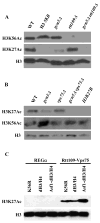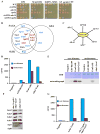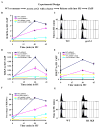A role for Gcn5 in replication-coupled nucleosome assembly
- PMID: 20188666
- PMCID: PMC2954627
- DOI: 10.1016/j.molcel.2010.01.020
A role for Gcn5 in replication-coupled nucleosome assembly
Abstract
Acetylation of lysine residues at the H3 N terminus is proposed to function in replication-coupled (RC) nucleosome assembly, a process critical for the inheritance of epigenetic information and maintenance of genome stability. However, the role of H3 N-terminal lysine acetylation and the corresponding lysine acetyltransferase (KAT) in RC nucleosome assembly are not known. Here we show that Gcn5, a KAT that functions in transcription, works in parallel with Rtt109, the H3 lysine 56 KAT, to promote RC nucleosome assembly. Cells lacking both Gcn5 and Rtt109 are highly sensitive to DNA damaging agents. Moreover, cells lacking GCN5 or those that express N-terminal H3 mutants are compromised for deposition of new H3 onto replicating DNA and also show reduced binding of H3 to CAF-1, a histone chaperone involved in RC nucleosome assembly. These results demonstrate that Gcn5 regulates RC nucleosome assembly, in part, by promoting H3 association with CAF-1 via H3 acetylation.
Copyright 2010 Elsevier Inc. All rights reserved.
Figures







Comment in
-
The tango of histone marks and chaperones at replication fork.Mol Cell. 2010 Mar 12;37(5):595-6. doi: 10.1016/j.molcel.2010.02.019. Mol Cell. 2010. PMID: 20227364
Similar articles
-
Roles for Gcn5 in promoting nucleosome assembly and maintaining genome integrity.Cell Cycle. 2010 Aug 1;9(15):2979-85. doi: 10.4161/cc.9.15.12498. Epub 2010 Aug 23. Cell Cycle. 2010. PMID: 20699646 Free PMC article.
-
Acetylation of histone H3 lysine 56 regulates replication-coupled nucleosome assembly.Cell. 2008 Jul 25;134(2):244-55. doi: 10.1016/j.cell.2008.06.018. Cell. 2008. PMID: 18662540 Free PMC article.
-
Histone-modifying enzymes, histone modifications and histone chaperones in nucleosome assembly: Lessons learned from Rtt109 histone acetyltransferases.Crit Rev Biochem Mol Biol. 2015 Jan-Feb;50(1):31-53. doi: 10.3109/10409238.2014.978975. Epub 2014 Nov 3. Crit Rev Biochem Mol Biol. 2015. PMID: 25365782 Free PMC article. Review.
-
The Ddc1-Mec3-Rad17 sliding clamp regulates histone-histone chaperone interactions and DNA replication-coupled nucleosome assembly in budding yeast.J Biol Chem. 2014 Apr 11;289(15):10518-10529. doi: 10.1074/jbc.M114.552463. Epub 2014 Feb 25. J Biol Chem. 2014. PMID: 24573675 Free PMC article.
-
Replication-Coupled Nucleosome Assembly in the Passage of Epigenetic Information and Cell Identity.Trends Biochem Sci. 2018 Feb;43(2):136-148. doi: 10.1016/j.tibs.2017.12.003. Epub 2017 Dec 29. Trends Biochem Sci. 2018. PMID: 29292063 Free PMC article. Review.
Cited by
-
Transcription-associated histone modifications and cryptic transcription.Biochim Biophys Acta. 2013 Jan;1829(1):84-97. doi: 10.1016/j.bbagrm.2012.08.008. Epub 2012 Sep 7. Biochim Biophys Acta. 2013. PMID: 22982198 Free PMC article. Review.
-
Functional tug of war between kinases, phosphatases, and the Gcn5 acetyltransferase in chromatin and cell cycle checkpoint controls.G3 (Bethesda). 2023 Apr 11;13(4):jkad021. doi: 10.1093/g3journal/jkad021. G3 (Bethesda). 2023. PMID: 36772957 Free PMC article.
-
Mutational signatures of redox stress in yeast single-strand DNA and of aging in human mitochondrial DNA share a common feature.PLoS Biol. 2019 May 8;17(5):e3000263. doi: 10.1371/journal.pbio.3000263. eCollection 2019 May. PLoS Biol. 2019. PMID: 31067233 Free PMC article.
-
The role of FACT in making and breaking nucleosomes.Biochim Biophys Acta. 2012 Mar;1819(3-4):247-55. doi: 10.1016/j.bbagrm.2011.07.009. Epub 2011 Jul 23. Biochim Biophys Acta. 2012. PMID: 21807128 Free PMC article.
-
Histone chaperones link histone nuclear import and chromatin assembly.Biochim Biophys Acta. 2012 Mar;1819(3-4):277-89. doi: 10.1016/j.bbagrm.2011.09.007. Epub 2011 Oct 8. Biochim Biophys Acta. 2012. PMID: 22015777 Free PMC article.
References
-
- Ai X, Parthun MR. The nuclear Hat1p/Hat2p complex: a molecular link between type B histone acetyltransferases and chromatin assembly. Mol Cell. 2004;14:195–205. - PubMed
-
- Balasubramanian R, Pray-Grant MG, Selleck W, Grant PA, Tan S. Role of the Ada2 and Ada3 transcriptional coactivators in histone acetylation. J Biol Chem. 2002;277:7989–7995. - PubMed
-
- Benson LJ, Gu Y, Yakovleva T, Tong K, Barrows C, Strack CL, Cook RG, Mizzen CA, Annunziato AT. Modifications of H3 and H4 during chromatin replication, nucleosome assembly, and histone exchange. J Biol Chem. 2006;281:9287–9296. - PubMed
-
- Candau R, Berger SL. Structural and functional analysis of yeast putative adaptors. Evidence for an adaptor complex in vivo. J Biol Chem. 1996;271:5237–5245. - PubMed
Publication types
MeSH terms
Substances
Grants and funding
LinkOut - more resources
Full Text Sources
Molecular Biology Databases

